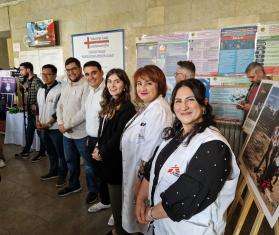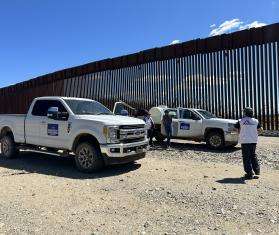Under any circumstances, it’s not an easy task traveling along muddy rainforest tracks by motorbike and crossing swollen rivers by dugout canoe. Now imagine doing it while carrying a refrigerator. This is exactly what UK native and Doctors Without Borders/Medecins Sans Frontieres (MSF) project coordinator Will Turner and his team will be doing for the next month as they mount an expedition to test 40,000 people in remote villages of Democratic Republic of Congo (DRC) for sleeping sickness (human African trypanosomiasis).
The mission is taking them to the town of Bili, among other places, in the far north of the country. Bili sits in a heavily forested area between the river Uélé and the border with Central African Republic. The area is a global hotspot for sleeping sickness, a disease transmitted by the tsetse fly that is fatal if it’s not treated. Some 85 percent of all sleeping sickness cases are found in DRC, in fact. But the region is so difficult to reach that the problem has long gone ignored.
“We came to the district because it is in the most active focus of sleeping sickness in the world,” says Turner. “Yet this fatal disease is just not tackled here due to insecurity and the remoteness of the area.”
In early April 2013, MSF’s mobile sleeping sickness team installed a laboratory and treatment ward in Bili hospital and began testing local people for the disease. Once the entire population of the town has been tested, the team will turn its focus to about 50 other villages located deep in the surrounding rainforest. People diagnosed with the disease will be referred to the hospital in Bili.
“The team will be on the road for three to four weeks in a row,” says Turner. “Sometimes they will be on motorbikes to make their way along barely accessible paths through the forest. They will move to a new village every day and sleep in tents. By doing this, we expect to find and cure several hundred infected patients.”
The logistical challenges are enormous. It can take up to a month for supplies to reach Bili. Small planes, landing on an improvised airstrip in the forest, can bring in only limited quantities of supplies on a given trip. Trucks carrying the cargo—which includes sensitive tools such as microscopes and centrifuges—have to be ferried across rivers on rafts, while muddy tracks are often blocked by toppled trees. During the rainy season, many of the villages are completely unreachable.
On top of this, the test for sleeping sickness is complex, with several components that have be kept cool at all times. Even in the most remote areas, the teams must travel with a generator and refrigerators.
But the mobile sleeping sickness team is prepared for these challenges, having done similar missions in South Sudan, Chad, Central African Republic, Republic of Congo, and elsewhere in DRC.
Most recently, the team spent nine months in South Sudan, another sleeping sickness hotspot that’s struggling to overcome the effects of decades of conflict. The team targeted villages across Central and Western Equatoria states, where sleeping sickness rates had previously been very high. Travelling thousands of kilometers from village to village, the team screened more than 60,000 people. Thirty-eight confirmed cases were identified and treated, indicating the good news that the prevalence of sleeping sickness in these areas has decreased significantly.
In addition to screening patients, MSF’s team also worked with Ministry of Health clinics to improve their screening, diagnosis, and treatment capacities. More than 200 South Sudanese staff received training that they will be able to put into practice in the years to come.
Back in Bili, Turner and his team hope to finish what was started four years ago, when an MSF team found and treated 120 patients with sleeping sickness in the area in just three months (before security reasons caused the project to be brought to a halt).
A short flight away, another MSF team is busy tackling sleeping sickness in and around the towns of Dingila and Ango.
“By screening and treating people over a wide area, we save lives, first and foremost, but we also reduce the prevalence of the disease,” says Turner. “Each person treated is a step in the right direction.”
But the difficult terrain, unwieldy kit, and regional insecurity are not the only challenges. “Until there are simpler and more suitable diagnostic tools and treatments, and dependable funding for national programs, eliminating the disease will continue to be an uphill struggle,” says Turner.





